- Author
- A.N. Other
- Subjects
- History - post WWII
- Tags
-
- RAN Ships
- None noted.
- Publication
- September 2023 edition of the Naval Historical Review (all rights reserved)
By Robert Graham Stephenson – Official No 7662 (NS)
This article has been taken from an original paper written by Robert Stephenson and published by the National Servicemen’s Association of Australia. As this is a lengthy paper it has been slightly edited and broken down into three parts. Part 1 below describes the National Servicemen Scheme and through it the introduction of young men into the RAN. Subsequent editions of this magazine will cover ‘Initial training at HMAS Cerberus’ and ‘Training cruises in HMAS Sydney III’.
Robert Stephenson was one of nearly 7000 young Australians aged 18 who were called up for service in the Navy. It was the 1950s and world tensions were high; communism was active close to Australia in Malaya, Vietnam, China and Korea. The Navy patrolled our sea lanes and helped transport service personnel and their equipment to war zones in south-east Asia.
Because of insufficient recruiting the Menzies Government wanted to boost our three services and National Service – named after the British scheme – was the result. Of the three services, the Navy was the one with the longest link to Australia beginning with the Royal Navy, from Cook in 1770 until Federation in 1901. Each colony had its own naval force and gunboats which were transferred to the Commonwealth. In 1911 the King granted Royal status.
Like us all, Able Seaman Stephenson was transformed from a young man to whom the services were something remote to a competent, self-sufficient serviceman.
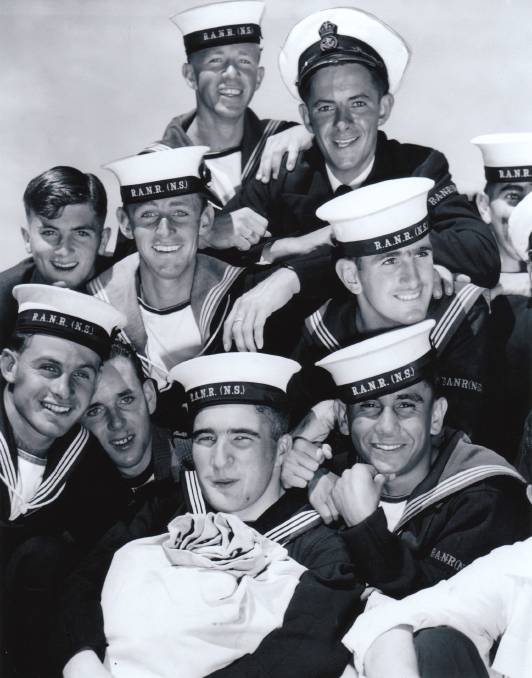
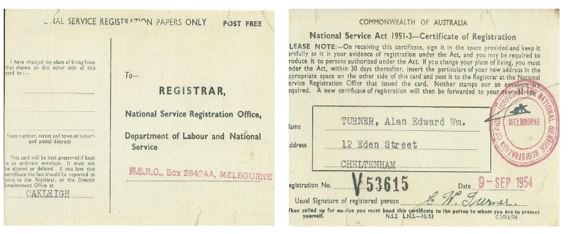
His account of his training and service makes good reading. Like all the 287,000 young men in the Navy, Army and Air Force, he helped forge a new tradition that will stand Australia in good stead should National Service be needed again.
National Service (Conscription) Post WWII: Overview
Many elements of this overview are the work of Allen Callaghan, a former journalist and a member of the National Servicemen’s Association of Australia (NSAA) Executive who has kindly given permission for its inclusion. The full text of Allen’s Brief History of National Service and Honour Rolls is available on line at the National Servicemen’s Association of Australia’s website: www.nashoaustralia.org.au
The First Scheme – 1951 to 1959
Following WWII and the outbreak of the Korean War, during what became known as the Cold War period, a perceived threat from communist countries, the Soviet bloc and Asian states to our north prompted the Menzies Government to enact a policy of conscription to boost Australia’s military strength and preparedness.
The National Service Act 1951 required eligible young men from all States turning 18 on or after 1 November 1950 to undertake military training over a period of five years in the Navy, Army and Air Force.
The majority were born from 1932 to 1940, before the start of WWII, and were from what is known as the ‘Quiet Generation’. Their parents lived through WWI and had also grown up during the Great Depression of the 1930s. Many of their parents were also involved in WWII, either as servicemen and women who served in the armed forces or in other war effort capacities. Sadly, some of their parents made the supreme sacrifice and many returned home suffering both physical and mental injuries. Therefore, this Quiet Generation understood the austerity and struggles their parents endured during those earlier tough times and some were old enough to take in the seriousness of the European conflict and even more so the war with Japan. Others were already working with returned servicemen and had a clearer understanding of their sacrifices and the hardships involved in times of war.
Corporal punishment was the norm for the Quiet Generation both at home and at school, and they were generally quite used to discipline.
The first scheme covered the period 1951 to 1959 and of the 500,000 eligible 18-year olds who registered, a total of about 227,000 were called up. Just under 7000 were allocated to the Navy, about 198,000 to the Army and approximately 22,000 for the Air Force.
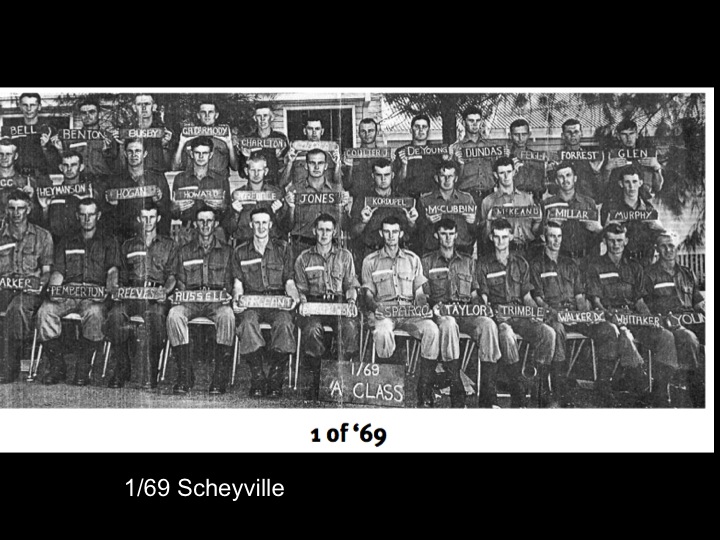
Although applicants could nominate a preferred service, those with family members who were either already serving or former service personnel, and others who trained as cadets were given preference by the Navy and Air Force. Overseas service was mandatory for both Navy and Air Force but voluntary for the Army. This continued the limits imposed on Army conscripts in WWII who could only serve in Australia or its adjacent territories in the south-west Pacific. Most Army National Servicemen volunteered.
The Navy and Air Force discontinued their training early in 1957; however the Army continued on with the training after 1957 but on a much reduced and more selective scale, calling up a further 2000, until 1959. The Government discontinued the scheme altogether on 24 November 1959 and on 30 June 1960 all the National servicemen were declared to have honourably discharged their obligations.
National Servicemen served in naval ships that operated in Korean waters during hostilities and were also present at the atomic bomb tests at the Monte Bello Islands off the coast of Western Australia in 1952. They were present at the Maralinga, South Australia atomic bomb tests in 1956 and National Servicemen worked on planes that had flown through atomic clouds. Some suffered from exposure to radiation, contracting radiation sickness. National Servicemen were placed on alert as part of a standby force for active service during the Suez crisis in 1956, however the crisis passed without Australia being involved.
The Second Scheme: 1965-1973
The second scheme came about following Australia’s involvement in confrontation with Indonesia from 1962 to 1966 and the Vietnam War from 1962 to 1972. Under the National Service Act 1964 a total of about 60,000 eligible 20-year-old men were selected by a birthday ballot for recruitment into the Regular Army for two years. All were considered available to serve overseas if required. Being born after the end of WWII they were from what is known as the Baby Boomer generation. There were no Navy or Air Force conscripts in the second scheme.
Just under 2000 of this group completed officer training at Scheyville in Sydney and were commissioned as second lieutenants; another 600 who were teachers were promoted to sergeant and posted to Papua-New Guinea for 12 months to educate soldiers of the Pacific Islands Regiment at Port Moresby and other PNG locations.
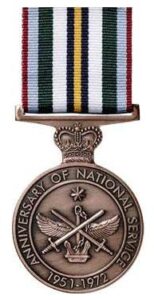
They saw active service in Borneo and Vietnam; garrison duty in Malaya; education of soldiers of the Pacific Island Regiment in Papua-New Guinea and garrison duty in Australia. Of the 16,000 who served in Borneo and Vietnam, two died in Borneo and 210 in Vietnam. Many were wounded and many more returned home suffering severe Post Traumatic Stress Disorder (PTSD) as a result of their service.
Regrettably, servicemen returning from Vietnam also suffered gross injustices as well as mental stress as a result of the activities of the anti-war movement and certain elements of the RSL who, at the time, claimed they hadn’t participated in a ‘real’ war.
Sadly, it was some years before they were finally rewarded for their service and given a fitting ‘welcome home’ parade through the streets of Sydney on 3 October 1987.
The Whitlam Government ended the second scheme with the National Service Termination Act 1973. The Defence Legislation Amendment Act of 1992 repealed the National Service Act 1951 but the then Labor Government retained conscription, in a time of war, with prior Parliamentary approval.
National Servicemen from both schemes were drawn from the whole community and many went on to achieve high office in defence, education, the law, medicine, politics and the public service as well as becoming leading businessmen, entrepreneurs and philanthropists. Others became sporting champions, entertainers and television personalities. There were two Governors General and five State Governors who were National Servicemen. Aboriginal and Torres Strait Islander and Pacific Islanders were also included in the ranks of National Servicemen.
In 2001, the Government recognised the contribution of National Servicemen to Australia’s defence preparedness with the award of the Anniversary of National Service 1951-1972 Medal. In 2006 National Servicemen, along with all other servicemen and women, were also awarded the Australian Defence Medal. National Servicemen were commonly referred to as ‘Nashos’, adding a new word to the Australian lexicon and the Oxford English Dictionary.
In1987, the National Servicemen’s Association of Australia was founded by a Vietnam veteran, the late Barry Vicary, at Toowoomba, Queensland to seek a better deal for Vietnam-era National Servicemen and the award of a medal recognising National Service.
When Barry learned of the earlier and much larger National Service Scheme he immediately widened the organisation to include them. The Association now has branches Australia wide and has become the second largest of the ex-Service organisations after the RSL.
In 2010 the National Servicemen’s Memorial was unveiled at the Australian War Memorial, Canberra by Her Excellency Ms. Quentin Bryce AC, Governor-General of the Commonwealth of Australia. Thousands of Nashos proudly marched up Anzac Avenue past the dais, saluting Lieutenant General Mark Evans AO DSC, Chief of Joint Operations, who was deputising for the Chief of the Defence Force, Air Chief Marshall Angus Houston AFC, along with General Peter Cosgrove AK CVO MC who commanded troops in Vietnam including Nashos, and Major Earle Jennings AM RFD ED, National President of the National Servicemen’s Association of Australia, as they moved into position for the unveiling and dedication service to commemorate and remember those who made the supreme sacrifice.
Despite the compulsion, National Servicemen of both schemes did their training and active and reserve duties honourably and well and most regarded it as a very rewarding part of their lives. Others also suggest it was a life changing experience, turning them from boys into men and becoming responsible citizens.
Many believe it should be reintroduced to give the youth of today skills and experiences that could change their lives and last them a lifetime. National Service Day, 14 February, marks the day the last Nasho completed his Army obligation.
Australia’s Defence Strategy during the 1950s
The 1950s became known as the ‘Era of Forward Defence’ and by the mid-1950s the nations of the Western alliance were in no doubt that they had entered a prolonged politico-economic struggle against the Eastern bloc.
Communist expansion remained a serious threat to international security; therefore as its part of Australia’s forward defence strategy the RAN under First Naval Member and Chief of the Naval Staff, Vice-Admiral Sir Roy R. Dowling, KBE CB DSO RAN, adopted the following plan:
- Provide a contribution to Allied naval forces in our areas of strategic interest.
- Escort Australian military convoys to operational areas.
- In conjunction with the RAAF, protect shipping carrying essential imports and exports within the Australian area.
- Co-operate with sister services in general operations, including the defence of the Australian mainland and territories.
- Carry out offensive operations against the enemy.
This plan remained in place until 1972; building up the numbers available for the RANR should the mothballed fleet need to be recommissioned at some future time formed an important part of this strategy.
Navy National Service 1951 to 1957
In July 1951, following the proclamation of the National Service Act 1951, a new arm of the Navy’s Reserve Forces (RANR) was instituted. Those called up for service were enlisted as recruits in the Royal Australian Navy Reserve (National Service) – RANR (NS). The Navy Reserve (RANR) was constituted under the Naval Defence Act 1910-1949 as a section of the Citizens’ Naval Forces.
Those called up for service with the Navy under the National Service Act 1951 were required to serve for a period of five years, during which they were to carry out 176 days continuous training.
Initially National Servicemen were required to complete 124 days of that training during their first year of enlistment, the first 82 days of which were undertaken in a regional shore establishment, plus 42 days in sea-going ships of the fleet. The remaining 52 days were completed over the next five years with the RANR. This was later changed to 154 days continuous training including sea-going service followed by attachment to the RANR for the remaining five years. In the event of war, or an emergency, National Servicemen were liable to be called up to serve in accordance with the provisions of the Naval Defence Act 1910-1949.
Over the life of its involvement with the National Service Scheme the Navy trained approximately 7000 eligible eighteen-year-olds, commencing on 30 July 1951 and terminating on 7 June 1957.
In total there were 12 intakes, each being identified by a name of either an Australian pioneer or explorer, viz. Blaxland, Burke, Eyre, Forrest, Hargraves, Hume, Macquarie, Oxley, Sturt and Wills. The last two intakes were; August 1956 – Blaxland II, and January 1957 – Burke II. The Navy ceased its involvement with National Service training on 7 June 1957.

Navy National Servicemen received a service number commencing at 1001 followed by the letters (NS). They trained at HMAS Torrens in Adelaide, South Australia; HMAS Huon in Hobart, Tasmania; HMAS Leeuwin at Fremantle near Perth, WA; HMAS Lonsdale in Melbourne, Victoria; HMAS Cerberus at Crib Point, Westernport, Victoria; HMAS Penguin in Sydney, NSW, and HMAS Albatross near Nowra, NSW.
Each intake consisted of about 500 recruits and training commenced in July 1951 followed by January/February and July/August each year with the last intake in January 1957. The majority completed their recruit training at the Navy’s main training base Cerberus which is also known as Flinders Naval Depot. Numbers 1001 (NS) to 1100 (NS) ratings trained at Leeuwin only and numbers 1101 (NS} to 1496 (NS) trained in other States – Adelaide in Torrens, Hobart in Huon, Melbourne in Lonsdale, Sydney in Penguin and Albatross, NSW. The first recruit with number 1001 (NS) was Robert Arthur Armstrong and the last with number 7941 (NS) Barry St. Clare Coxhell.
National Service Recruit Training
The first intake of 500 Nasho recruits, Blaxland I, commenced training on 30 July 1951; 400 at Cerberus and 100 at Leeuwin. All of the first intake were trained as seamen and their first training period of 124 days included six weeks at sea. Having completed the initial training, they left their respective bases and returned home on 30 November.
They could decide whether they would do the rest of their training at the rate of 13 days a year over the next four years or whether they would join the RANR in which they would do 13 days annual sea-going training and 15 days home training for three years.
It was expected that about fifty percent of those who left Flinders Naval Depot on 30 November would choose the latter course. At the end of the three years they would be invited to re-engage in the RANVR.
The first annual sea-going training of 13 days for New South Wales Nasho recruits commenced on 29 June and 20 July 1952 on board the frigate HMAS Murchison.
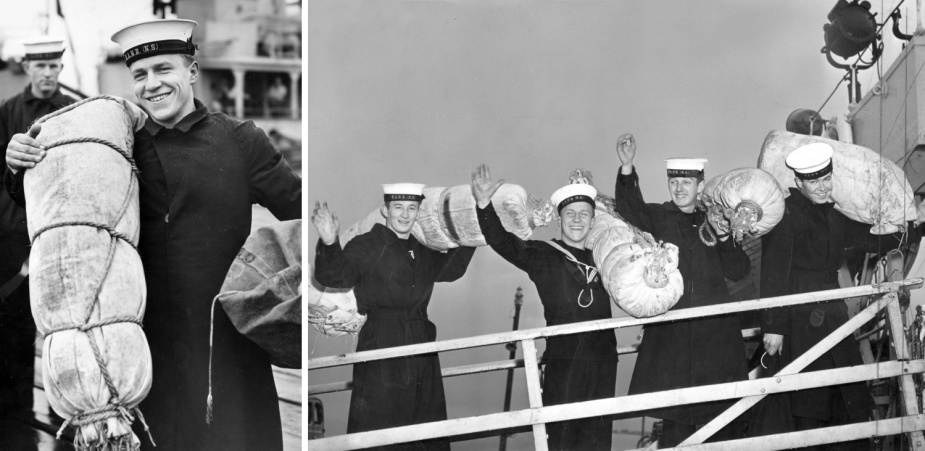
Queensland recruits joined the same ship in Sydney on 10 August 1952 for their initial sea training.
The frigate HMAS Culgoa sailed from Port Adelaide on 26 July 1952 with South Australian Nashos and naval reservists. Tasmanian Nashos left Hobart with reservists on the same ship on 11 August 1952.
Victorian Nashos embarked on the minesweepers HMA Ships Colac and Cowra on 07 and 21 July 1952. Those from WA left Fremantle aboard the minesweeper HMAS Mildura on 14 and 28 July and 04 August, 1952.
Minister for the Navy, the Honourable William McMahon MP, commented favourably to the press about the quality of the first National Service recruits:
‘While these young men have been undergoing training their conduct has been exemplary and they have accepted the responsibility of learning to defend their country in the right spirit. They have obviously enjoyed their experience and have benefitted both morally and physically from it. They were encouraged by the fact that some of them were selected to take part in the spectacular Trafalgar Day ceremony at Como Park, South Yarra, on Sunday, October 21.
‘They have held their own with ratings of the permanent Royal Australian Navy in all competitive games and team work at the depot and have created a very favourable impression among the officers under whom they have trained. A number of them have already indicated that they are considering joining the RAN’.
On 7 August 1951 the First Naval Member, Chief of the Naval Staff, Vice-Admiral Sir John Collins KBE CB RAN visited Flinders Naval Depot and reviewed the National Service trainees collectively, and the occasion was a high-spot in the trainees’ career.
Another high-spot was when the Commodore Superintendent of Training, Commodore H.J. Buchanan DSO RAN,addressed them on 15 August 1951 and explained to them their place in the nation’s defence. He commented:
‘Many of the lads are already enamoured of service life, and there have been many enquiries from them for conditions of joining the permanent naval forces. In a very fair manner the RAN will not entertain applications for transfer to the permanent forces until the lads have been in the service long enough to judge whether the life would really suit them. If after this period these chaps are still determined on a Navy life, then they will surely be welcomed.
‘Even in the short time they have been here, they have left their mark on the Depot’s life on parade, in the class room and in sport – and if the next batch of National Service trainees are half as good a lot as these lads are – then the Navy will have no grumbles.’
The second intake Burke 1 numbering 414 entered Flinders Naval Depot on 04 February 1952 and these trainees were allocated to all branches of the service. After initially completing 124 days at their respective bases, 13 days of continuous service at sea was to be undertaken each year over the next four years.
Each State was represented by trainees from both city and country areas and after three weeks settling down the first 160 proceeded to sea in Culgoa, Colac and Cowra to NSW ports, the second 160 to South Australia three weeks later.
In April the three training ships took 140 regular recruit seamen and Nashos on a month’s trip to New Zealand visiting Auckland, Russell in the Bay of Islands, Napier, Lyttelton, Christchurch, Dunedin, St. George Sound and Norfolk Sound. A busy social programme kept the ships’ companies fully occupied during their spare moments while training.
A march of combined ships’ companies and trainees took place through Napier; on Anzac Day a guard was mounted at Christchurch, and an unarmed platoon at Lyttleton. A number of complimentary remarks were received on the high standard of drill and appearance. In view of the fact that few RAN ships had visited some of the smaller places in recent years, great enthusiasm was found amongst the locals and the hospitality was overwhelming.
The visit to New Zealand was a wonderful experience for all on board and one particular trip that stunned everybody on board Culgoa was a cruise right to the end of Milford Sound, a deep-water inlet with magnificent scenery and snow-capped mountains. Culgoa had almost 5000 visitors at Napier in one afternoon.
The return from New Zealand caught all ships in a deep depression, and on arrival at Flinders Naval Depot, all the trainees were justified in shooting a line about the weather they had experienced. Culgoa lost her whaler and had many guard-rail stanchions either bent or torn from the deck. Soup and stew were available for those who required food but for two days there was little demand.
When at sea for the second time the stokers visited Sydney and were shown around the naval establishments and ships. There was great interest in Garden Island, HMAS Sydney and HMAS Tobruk. Other cruises included Tasmania and all trainees were most enthusiastic about the ‘Apple Isle’.
The following intakes experienced similar training in sea-going ships until the RAN used the aircraft carrier on loan from the Royal Navy, HMS Vengeance (renamed HMAS Vengeance), as a training ship from July 1954. SydneyIII superseded Vengeance‘s role after she was recommissioned as a training ship in 1955.
So ends Part I of our Nasho Odyssey. Part II in the next edition of this magazine covers initial training of National Servicemen at Cerberus where they were taught by, amongst others, Petty Officer Perfect.




